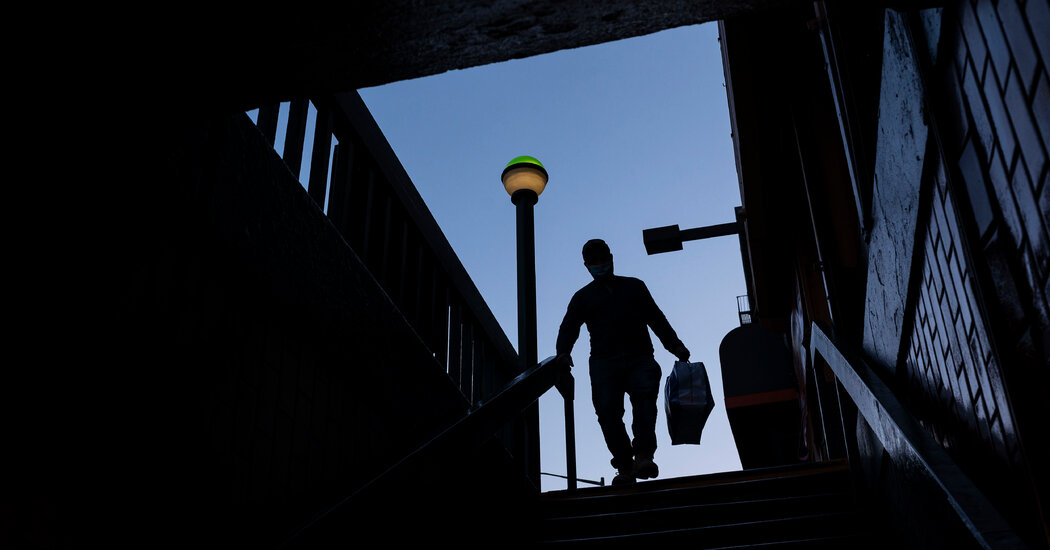Remember when New York City was doomed? The first wave of the Covid-19 pandemic hit the city like a hammer, killing more than 20,000 New Yorkers over the course of a few months. And many commentators asserted that it was New York’s lifestyle — in particular, its uniquely high population density and reliance on mass transit — that made it so vulnerable.
As it turned out, however, this was all wrong. New York suffered badly at the beginning because it’s still America’s leading gateway to the world, so it got heavily infected first, at a time when we didn’t know much about how to protect ourselves from the coronavirus. Since then the city has done pretty well on the health front.
It has not, however, done nearly as well on the economic front. And thereby hangs a tale that’s relevant not just to New York, but to blue America in general.
About the pandemic: During the Delta wave, the combination of high vaccination rates, widespread mask-wearing and public health precautions — you can’t do much indoors in the Big Apple without showing your vaccine card — helped make New York one of the safer places in America, suffering a far lower Covid-related death rate than rural counties or sprawling, car-dependent cities like Dallas. The Omicron wave also hit New York first but appears to be receding fast.
And soaring rental rates, which appear to be more or less back to their prepandemic level, suggest that New York is once again seen as an attractive place to live. Sorry, but I can’t resist quoting the investment manager who declared, “The main problem with moving to Florida is you have to live in Florida.”
Indeed, New York is a great place to live — if you can afford the cost of housing. That last point, however, is a problem, and it lies behind the city’s lagging economic recovery.
All of America suffered steep job losses in the early months of the pandemic. New York City’s job losses, however, were much bigger in percentage terms than the national average, and as the national economy has recovered New York hasn’t made up the lost ground.
What’s behind this underperformance? Some of it reflects the effects of the pandemic on tourism and business travel — Times Square was just starting to become intolerable again (normally nobody goes there because it’s too crowded) before Omicron hit. But the larger issue, I’d argue, is New York’s lack of economic diversity.
That may seem a strange thing to say about a city that is incredibly diverse in so many ways — including the jobs people have. But a city’s economic fortunes are largely driven by its “export base” — the things it produces that are sold elsewhere. This base normally has a large “multiplier”: Much of the money earned in the base is spent locally, supporting restaurants, shops, gyms and more. But the base is what drives the city’s growth.
And New York’s base is remarkably narrow for a city its size. As Harvard’s Ed Glaeser has pointed out, in economic terms the city is pretty much a monoculture: It sells financial services to the rest of the world and not much else.
Just looking at employment numbers can be misleading: Only about 8 percent of New York’s workers are employed in finance and insurance. But their incomes are so high compared with everyone else’s that they account for about 20 percent of the city’s economy and most of its export base.
And the trouble with having a one-industry economy is that bad things happen if something undermines that industry. Think of coal in West Virginia or cars in Flint, Mich.
The odd thing about New York’s troubles is that in some ways the city’s export base has been holding up fine; Wall Streeters aren’t decamping en masse. But what Wall Street has stopped doing, for now at least, is going to the office — because finance turns out to be one of those industries in which a lot of work can be done remotely. This in turn means that financial workers aren’t buying lunch, shopping downtown, going out to eat and so on. The problem, in other words, is less a shrinking base than a reduced multiplier.
But why has New York lost its economic diversity? The answer, surely, is that the immense purchasing power of Wall Street and those who serve it has collided with a housing stock limited by zoning and regulation, making the city too expensive for everyone except financiers and those who, directly or indirectly, cater to their needs. And the solution is obvious: Allow more housing to be built.
Which brings me to the question of what’s wrong with blue America — with New York just one example (California is worse). Conservatives will tell you that people are moving to Texas and Florida for the low taxes; but while New York’s taxes are indeed high, there’s not much evidence that they’re driving high-income residents away. What people are really doing is moving to places where housing is affordable, because governments don’t block new construction.
And in the case of New York, NIMBYism is ultimately the reason a great global city has become a one-industry town, leaving it unusually vulnerable to pandemic-driven economic dislocations.
The Times is committed to publishing a diversity of letters to the editor. We’d like to hear what you think about this or any of our articles. Here are some tips. And here’s our email: letters@nytimes.com.
Follow The New York Times Opinion section on Facebook, Twitter (@NYTopinion) and Instagram.


























